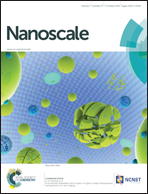Towards the continuous production of high crystallinity graphene via electrochemical exfoliation with molecular in situ encapsulation†
Abstract
Large-scale production of uniform and high-quality graphene is required for practical applications of graphene. The electrochemical exfoliation method is considered as a promising approach for the practical production of graphene. However, the relatively low production rate of graphene currently hinders its usage. Here, we demonstrate, for the first time, a rapid and high-yield approach to exfoliate graphite into graphene sheets via an electrochemical method with small molecular additives; where in this approach, the use of melamine additives is able to efficiently exfoliate graphite into high-quality graphene sheets. The exfoliation yield can be increased up to 25 wt% with melamine additives compared to electrochemical exfoliation without such additives in the electrolyte. The proposed mechanism for this improvement in the yield is the melamine-induced hydrophilic force from the basal plane; this force facilitates exfoliation and provides in situ protection of the graphene flake surface against further oxidation, leading to high-yield production of graphene of larger crystallite size. The residual melamine can be easily washed away by water after collection of the graphene. The exfoliation with molecular additives exhibits higher uniformity (over 80% is graphene of less than 3 layers), lower oxidation density (C/O ratio of 26.17), and low defect level (D/G < 0.45), which are characteristics superior to those of reduced graphene oxide (rGO) or of a previously reported approach of electrochemical exfoliated graphene (EC-graphene). The continuous films obtained by the purified graphene suspension exhibit a sheet resistance of 13.5 kΩ □−1 at ∼95% transmittance. A graphene-based nanocomposite with polyvinyl butyral (PVB) exhibits an electrical conductivity of 3.3 × 10−3 S m−1 for the graphene loading fraction of 0.46 vol%. Moreover, the melamine functionalized graphene sheets are readily dispersed in the aqueous solution during the exfoliation process, allowing for the production of graphene in a continuous process. The continuous process for producing graphene was demonstrated, with a yield rate of 1.5 g h−1. The proposed method can produce high-crystallinity graphene in a fast and high-yield manner, which paves the path towards mass production of high-quality graphene for a variety of applications.


 Please wait while we load your content...
Please wait while we load your content...